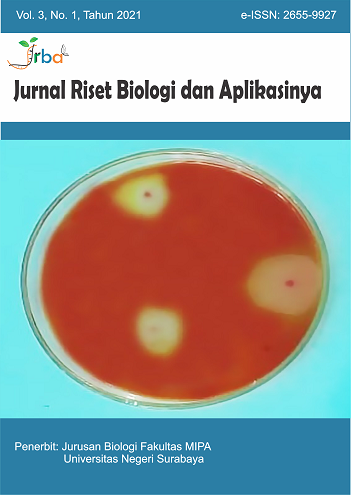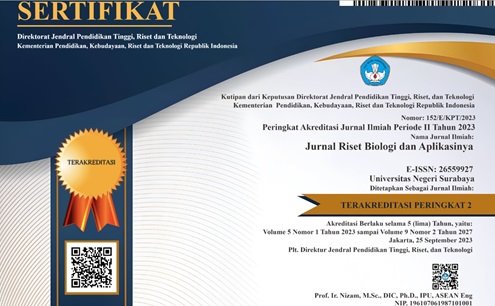Distribution Patterns of Exotic Plant Chromolaena odorata, in Rehabilitation Zone at Donglo Block, Resort of Wonoasri, Meru Betiri National Park
DOI:
https://doi.org/10.26740/jrba.v3n1.p1-6Keywords:
Chromolaena odorata, distribution pattern, exotic plants, Meru Betiri National ParkAbstract
Exotic plants are plants that are introduced intentionally or unintentionally from their original habitat to a new habitat. One of the exotic plants that is potentially invasive is Chromolaena odorata. These plants are found a lot especially in the rehabilitation zone at Donglo Block Resort of Wonoasri, Meru Betiri National Park (MBNP). An initial effort to determine whether this exotic plant was potentially invasive was to use the distribution pattern of a plant population. This study aimed to determine the distribution pattern and area of cover of exotic plants C. odorata in rehabilitation zone at Donglo Block, Resort of Wonoasri MBNP. The sampling of C. odorata used the transect plot method systematically, which carried out in Donglo Block Resort of Wonoasri MBNP. Data analyzed using Morisita index. The map of distribution pattern of C. odorata was created using the Geographic Information System (GIS). Based on the results of the Morisita index, the value (I?) = 12.39, which means that C. odorata has a clumped distribution pattern. The distribution pattern of C. odorata can also be seen from the visualization of the spatial distribution map, which shows that the growth of C. odorata in plants or overlaps with each other, hence that it looks clustered. The coverage area of C. odorata in the study location was 596,5 m2 or 29.24% of the total area of the study (20,400 m2). Based on the results of the coverage area of C. odorata, it was indicated that this exotic species is not yet classified as an invasive species in the area.
References
Ambika, S. (2006). Effect of light quality and intensity on emergence, growth and reproduction in Chromolaena odorata. Proceedings of the Seventh International Workshop on Biological Control and Management of Chromolaena Odorata and Mikania Micrantha, 2002, 1427. Available at http://jprsolutions.info.
Backer, C., and Reinier, C. B. V. B. 1963. Flora of Java. Universitas Michigan: P. Noordhoff.
Dewi, V. P., Hindun, I., & Wahyuni, S. (2015). Studi Trikoma Daun Pada Famili Solanaceae Sebagai Sumber Belajar Biologi. JPBI (Jurnal Pendidikan Biologi Indonesia), 1(2), 209218. https://doi.org/https://doi.org/10.22219/jpbi.v1i2.3332.
Google Earth. 2020. https://earth.google.com/web/@-8.38025995,113.69595945,30.16696257a,11499.39845315d,35y,0h,45t,0r/data=CksaSRJDCiUweDJkZDY5ZWYzOTFmOGY4YzU6MHg0ZmFmNDBjMjNhOTM1NDJkGYUrwnCxCDAIQKPuXy1a1xAKghXb25vYXNyaRgCIAEoAg [accessed on 11 April 2020].
Krebs, C. J. 1989. Ecologycal Methodology. New York (US): Harper and Row publisher.
Lestari, E.P., Dharmono, D., & Amintari, S. (2017). Pola Distribusi Tumbuhan Mahar di Desa Batu Tangga Kecamatan Batang Alai Timur Kabupaten Hulu Sungai Tengah. Available at https://www.semanticscholar.org/paper/Pola-Distribusi-Tumbuhan-Mahar-(Kleinhovia-hospita-Lestari-Dharmono/a260d9610611b0cb8bdaedb5da3ca6b8c146eb0d.
Mandal, G., & Joshi, S. P. (2014). Invasion establishment and habitat suitability of Chromolaena odorata (L.) King and Robinson over time and space in the western Himalayan forests of India. Journal of Asia-Pacific Biodiversity, 7(4), 391400. https://doi.org/10.1016/j.japb.2014.09.002.
Oktary, A. P., Ridhwan, M., & Armi. (2015). Ekstrak Daun Kirinyuh (Eupatorium odoratum) Dan Lalat Buah (Drosophila melanogaster). Serambi Akademica, III(2), 335342. https://doi.org/https://doi.org/10.32672/jsa.v7i2.
Odum, E. P. 1993. Dasar-Dasar Ekologi. Edisi Ke-3. Yogjakarta: Gadjah Mada University Press.
Odum, E. P. 1971. Fundamental of Ecology Third Edition. London (GB): WB Saunders Company Press.
Prawiradiputra, B. (2007). Ki Rinyuh (Chromolaena Odorata (L) R.M. King Dan H. Robinson): Gulma Padang Rumput Yang Merugikan. 17(1), 4652.
Radiansyah, D. A., Adi, S., Wandojo, S., Soekisman, T., Daisy, J. D., Titiek, S., Budi, S., Islana, E., Sugeng, H., Fauziah., Ridwan, A., Awliya, P. A., & Nararya, G. 2015. Strategi Nasional dan Arahan Rencana Aksi Pengelolaan Jenis Asing Invasif di Indonesia. Jakarta: Deputi Bidang Pengendalian Kerusakan Lingkungan dan Perubahan Iklim, Kementrian Lingkungan Hidup dan Kehutanan Republik Indonesia.
Silalahi, M. 2015. Bahan Ajar Morfologi Tumbuhan. Jakarta: Universitas Kristen Indonesia.
Short, F.T. and Coles, R. 2001. Global Seagrass Research Methods. The Netherlands: Elsevier Publishing.
Suci, C. W., & Heddy, S. (2018). Pengaruh Intensitas Cahaya terhadap Keragaan Tanaman Puring (Codiaeum variegetum). Jurnal Produksi Tanaman, 6(1), 161169. http://protan.studentjournal.ub.ac.id/index.php/protan/article/view/627.
Suharjo, R., & Aeny, T. N. (2011). Eksplorasi Potensi Gulma Siam ( Chromolaena Odorata ). Jurnal Hama Dan Penyakit Tumbuhan Tropika, 11(2), 201209. https://doi.org/https://doi.org/10.23960/j.hptt.211201-209.
Suryawan, D., Sutyarto, E., Umaya, R., Kurnia, A & Hadiyan, Y. (2015). Sebaran invasive alien species Acacia decurrens pada kawasan Taman Nasional Gunung Merapi. Pros Sem Nas Masy Biodiv Indon, 1(4), 738742. https://doi.org/10.13057/psnmbi/m010409.
Susetiono. 2004. Fauna Padang Lamun tanjung Merah Selat Lembeh. Jakarta: Pusat Penelitian Oseanografi, LIPI.
Susilo, A. (2018). Inventarisasi Jenis Tumbuhan Asing Berpotensi Invasif di Taman Nasional Meru Betiri. Seminar Nasional Pendidikan Biologi dan Saintek, 3, 260270.
Syah, T. & Arbain. (2019). Assessment of Sesbania sesban as a Putative Invasive Species in Urban Area of Sangatta, East Kalimantan. Jurnal Ilmu Pertanian Indonesia, 24(4), 304312. https://doi.org/10.18343/jipi.24.4.304.
Tripathi, R. S., Yadav, A. S., & Kushwaha, S. P. S. (2011). Biology of Chromolaena odorata, Ageratina adenophora and Ageratina riparia: A review. Invasive Alien Plants: An Ecological Appraisal for the Indian Subcontinent, August 2016, 4356. https://doi.org/10.1079/9781845939076.0043.
Wijayanto, N. & N. (2012). Intensitas Cahaya, Suhu, Kelembaban Dan Perakaran Lateral Mahoni (Swietenia Macrophylla King.) Di Rph Babakan Madang, Bkph Bogor, Kph Bogor. Jurnal Silvikultur Tropika, 3(1), 813.
Yuliana, S., & Lekitoo, K. (2018). Deteksi Dan Identifikasi Jenis Tumbuhan Asing Invasif Di Taman Wisata Alam Gunung Meja Manokwari, Papua Barat. Faloak, 2(2), 89102. https://doi.org/https://doi.org/10.20886/jpkf.2018.2.2.89-102.
Downloads
Published
How to Cite
Issue
Section
 Abstract views: 746
,
Abstract views: 746
, PDF Downloads: 590
PDF Downloads: 590












